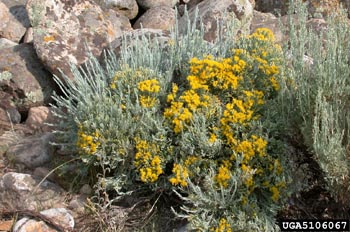Gray Horsebrush

Scientific Name:
Tetradymia canescens DC.
Scientific Name Synonyms:
None known
Symbol:
TECA2
Description:
Life Span: Perennial
Origin: Native
Season: Warm
Growth Characteristics: A highly branched shrub, with spreading or ascending branches, growing 8 to 32 inches tall. It resembles sagebrush in color and growth form. Flowers May to September and reproduces from seeds and root sprouting.
Flowers/Inflorescence: Flowers are bright yellow to cream, with pale lemon color being the most common. Long hairs surround the flowers. There are four to six bracts per head, hence the name Tetradymia. The flowers are similar in appearance to rabbitbrush flowers, only larger.
Fruits/Seeds: Fruit is a densely silky achene.
Leaves: Alternate, blades narrow lance-shaped, being ¾ to 1 inch long. The margins are entire and the leaf has a prominent midvein. The surface is wooly, giving the new leaves a silvery appearance.
Stems: Erect, short, stout, highly branched. New growth is densely silvery hairy. Older bark is gray, and shreddy. Old leaf bud scars appear swollen, giving the stem a Knobby appearance.
Ecological Adaptions:
Gray horsebrush is common on barren plains and foothills, and in deserts, at elevations from 4,400 to 10,500 feet. It is drought tolerant and will thin out and drop its leaves in periods of water stress.
The occurrence of fire greatly enhances the ability of Gray horsebrush to dominate a site.
Soils: Most abundant on sandy or rocky soils.
Associated Species: Douglas rabbitbrush, big sagebrush, sandberg bluegrass.
Uses and Management:
Gray horsebrush is poor to worthless as forage for cattle, sheep, goats, and big game. It is consumed only when other forage is unavailable. Gray horsebrush causes photosensitization in sheep. Symptoms are called "big head" or "swell head" from swelling of the head and facial features. Alkaloids may also cause liver damage followed by death in sheep. Poisoning most often occurs in the spring where good feed is lacking, and gray horsebrush is actively growing. Abortion may also result from liver damage caused by the toxins in gray horsebrush.
Sheep should be managed so as to avoid gray horsebrush. Most losses occur during stormy periods and when trailing sheep through horsebrush ranges. Consumption of black sagebrush enhances the toxic action of horsebrush on sheep.
Hopi Indians made a tonic from the leaves and roots for uterine disorders.

